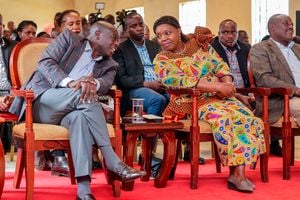Laikipia County resorts to mass livestock tagging to curb rustling

A livestock officer inspects a tag on a cow.
Laikipia County has embarked on a mass livestock tagging exercise to ease identification and traceability of lost animals.
The exercise, which is being carried out by the county’s livestock department in partnership with the national government, the Kenya Directorate of Veterinary Services, KCB Foundation and the World Vision, is also aimed at curbing cases of cattle rustling which has been a thorny issue in the region.
According to county Livestock Chief Officer James Mungere, animals will be tagged with the Livestock Identification and Traceability System (LITS) on their ears, and their details uploaded onto a database that will provide medical histories of the animals, assist in tracking and owner identification.
“The technology that is being used is known as Ripple Namir Waves application and it will offer real-time livestock tracking and, therefore, provide the platform for an effective national reporting system and enable programmes for the prevention and control of livestock diseases. The system is also expected to go a long way in tracing lost or stolen animals,” said Mr Mungere.
GPRS-enabled tag
The chief officer said that the tag, which is GPRS-enabled, carries with it the farmer’s name, vaccination history, age, type, location and colour of the animal.
“We have already engaged representatives from 13 community ranches on the benefits of the identification and animal tags. County veterinary officers and other livestock officers have been trained on how to sensitise the farmers and carry out animal tagging and identification process,” he said.
While emphasising the importance of the system in keeping animal health records, Kenya Veterinary Association (KVA) chair Dr Samuel Kahariri said the system will also help both county and national governments in surveillance, control and eradication of animal diseases.
“The ability to geographically visualise the registration of individual animals, farms, holdings, premises and herds enables us to identify risk areas, create disease-free zones and to assure livestock traceability for trade and food safety,” said Dr Kahariri at Segera in Laikipia North.
Kenya Commercial Bank Foundation livestock programme manager Bernard Barasa said farmers can access credit and insurance using the identified livestock as collateral.
Loans
“After the identification process, farmers can get a loan of up to Sh250 million from the foundation with no interest among other benefits when in a group,” he said.
Governor Ndiritu Muriithi has also told the Nation that the system will help achieve compliance with requirements of international trade.
This, according to the county boss, will be an added advantage to livestock farmers as they will be able to access international markets.
“By traceability, we are talking about our farmers having access to international markets as the system will enable consumers to access information about the livestock,” he said.





